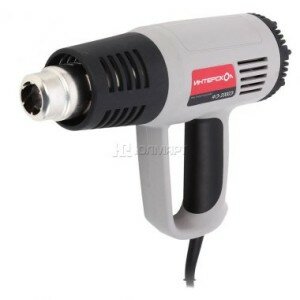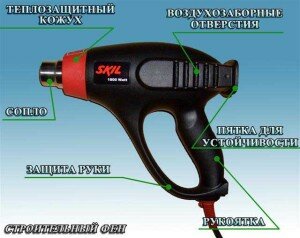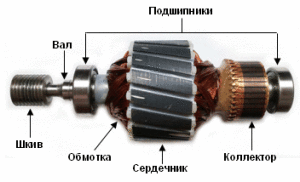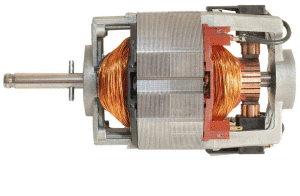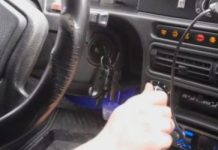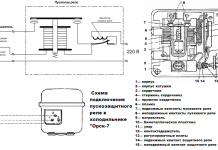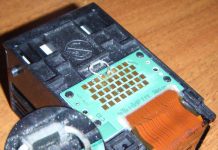In detail: do-it-yourself repair of an industrial hair dryer interskol 2000e from a real master for the site my.housecope.com.
We all are familiar with such an auxiliary tool in construction as a construction electric hair dryer, which we are used to using for removing paint and varnish coatings.
The fundamental principle of operation of a construction hair dryer is not much different from an ordinary hair dryer that we use to dry our hair.
Accordingly, the electrical circuit of a building hair dryer is similar to the electrical circuit of an ordinary hair dryer.
An explanation will be given in the stated topic:
- electrical diagram of a building hair dryer;
- the principle of the construction hair dryer;
- possible reasons for the malfunction;
- elimination of these malfunctions.
Consider the electrical circuit in Fig. 1 of the building hair dryer:
One diagonal of the diode bridge is connected to an external source of alternating voltage 220V.
The other diagonal of the diode bridge is connected to the electric motor.
The electrical diagram consists of the following elements:
- toggle switch performing the control temperature mode - K1;
- a toggle switch that controls the speed of the blowing speed of the electric motor rotor - K2;
- toggle switch for disconnecting heating elements - K3;
- fan motor - M;
- capacitor - C;
- Heating elements - RTEN;
- diodes - VD1, VD2.
Through the diode bridge circuit of one diagonal of the bridge, the rectified current of two potentials +, - is supplied to the electric motor. When passing from the anode to the cathode, the current flows with a positive half-cycle of the sinusoidal voltage.
Two capacitors connected in parallel in an electric circuit serve as additional smoothing filters.
The blowing speed occurs due to the variability of the resistance in the electrical circuit, that is, when the speed toggle switch is switched to the highest resistance value, the rotation speed of the electric motor rotor decreases due to the voltage drop.
| Video (click to play). |
The number of heating elements of heaters in this scheme is four. The temperature regime of the construction hair dryer is carried out by the temperature control toggle switch.
The heating elements in the electric circuit have different resistance, - accordingly, the heating temperature when switching from one section of the electrical circuit to another - heating the heating elements will correspond to its resistance value.
The general appearance of the construction hair dryer with its names of individual parts is shown in Fig. 2
The following electrical diagram of the building hair dryer in Fig. 3, is comparable to the electrical circuit in Fig. 1
There is no diode bridge in this wiring diagram. Blowing speed control and temperature control - occurs when switching from one section of the electrical circuit to another, namely:
- when switching to a section of an electrical circuit - consisting of a diode;
- when switching to a section of an electrical circuit that does not have a diode.
When a current flows in the anode-cathode junction of the VD1 diode, which has its own resistance, the heating element2 will heat up according to two resistance values:
- resistance at the transition anode - cathode diode VD1;
- resistance of heating element heating element 2.
When a current flows in the anode-cathode junction of the diode VD2, the voltage supplied to the electric motor and the heating element1 will take the lowest value.
Accordingly, the speed of rotation of the rotor of the electric motor and the heating temperature of the heating element for a given section of the electric circuit will correspond to the direct transition of the current of the diode VD2. Heating of the heating element heating element1 for a given section also depends on its internal resistance, that is, the resistance of the heating element is taken into account.
The main reasons for the malfunction of the construction hair dryer here can be called the malfunction of the electronic elements:
Most often, such a malfunction occurs with a sharp jump in an external source of alternating voltage. For example, the cause of a capacitor malfunction is caused by the fact that the capacitor plates are short-circuited when there is a voltage jump among themselves.
Of course, such a possibility of a malfunction as a rupture in the stator winding of an electric motor, winding burnout, is not excluded.
Minor malfunctions include such reasons as:
- oxidation of the temperature control toggle switch contacts;
- oxidation of the contacts of the toggle switch for controlling the blowing speed;
- oxidation of the contacts of the toggle switch for disconnecting the heating elements;
- a wire break in a network cable;
- defective plug lack of contact.
Diagnostics to identify the cause of the malfunction is carried out by the "Multimeter" device.
When replacing a capacitor, its capacity and voltage rating are taken into account.
When replacing a diode, the resistance of two values is taken into account, in the directions:
- from anode to cathode;
- from the cathode to the anode.
As we know, the value of resistance from anode to cathode will be significantly less than from cathode to anode.
With an electric motor, if it malfunctions, things are more complicated. With such a malfunction, it is easier to replace the electric motor than it is permissible to rewind the stator windings. But even such work is doable - who is directly involved in such repairs. In this case, the following is taken into account:
- the number of turns in the stator winding;
- section of copper wire.
Such a malfunction as burnout of the heating element is not excluded. Replacing the heating element is carried out taking into account its resistance value.
Consider the device of electric motors and how exactly it is necessary to diagnose electrical machines, as they are usually considered in the section on electrical engineering.
For an illustrative example, photographs of several types of such electric machines are presented - related to collector motors. The device and principle of operation are admissible two collector electric motors:
- is no different. The difference in electric motors is only in the rotor speed and in the power of the electric motor. Therefore, we, as it were, will not focus our attention in the sense that explanations are given that are not related to the electric motor of the construction hair dryer.
The electric motor of the building hair dryer is asynchronous, collector, single-phase alternating current.
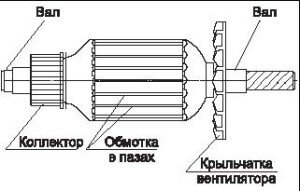
The rotor device does not require any explanation, since everything is shown in the photograph in Fig. 4 and a schematic representation of the electric motor rotor.
asynchronous collector motor single-phase alternating current
The electrical diagram of the collector motor in Fig. 5 is as follows:
In the circuit, we can notice that the collector motor can operate on both alternating and direct current - these are the laws of physics.
The two stator windings of the electric motor are connected in series. Two graphite brushes in contact - in electrical connection with the motor rotor collector.
The electrical circuit closes on the rotor windings, - accordingly, the rotor windings in the electrical circuit are connected in parallel through the brush-collector sliding contact.
diagnostics of stator windings of an electric motor
The photograph shows one of the methods for diagnosing the stator windings of an electric motor. In this way, the integrity or insulation breakdown of the stator windings is checked. That is, one probe of the device is connected to any of the brought out ends of the stator windings, the other probe of the device is connected to the stator core.
In the event that the insulation of the stator winding is broken and the winding wiring shorts to the core, the device will indicate a zero resistance value in the short circuit mode. It follows from this that the stator winding is defective.
The device in the photograph indicates a one when diagnosing - this does not mean that this stator winding is suitable for operation.
It is also necessary to measure the resistance of the windings themselves.Diagnostics is carried out in the same way in a similar way, - the probes of the device are connected to the withdrawn ends of the stator winding wires. With the integrity of the windings, the display of the device will indicate the resistance value possessed by this or that winding. If one or another stator winding breaks, the device will show "one". If the stator winding wires are short-circuited with each other as a result of overheating of the electric motor or for other other reasons, the device will indicate the lowest zero resistance value or "short circuit mode".
How to check the resistance of the rotor winding with a device? - To do this, you need to connect two test leads of the device to two opposite sides of the collector, that is, you need to make the same connection that graphite brushes have in electrical connection with the collector. The diagnostic results are reduced to the same indications as when diagnosing the stator windings.
What is a collector in general? - The collector is a hollow cylinder consisting of small copper plates of a special alloy, isolated from each other and from the rotor shaft.
In the event that the damage to the collector plates is insignificant, the collector plates are cleaned with fine-grained emery paper. Again, this amount of work can be performed directly only by specialists who repair electric motors.
The electrical circuit in Fig. 7 consists of a battery and a light bulb, this circuit is comparable to that of a pocket flashlight. One end of the negative potential wire is connected to the stator core, the other end of the positive potential wire connects to one of the brought out ends of the stator windings. If the wires are connected the other way around, that is, "plus" to the stator core, "minus" to the withdrawn end of the stator winding, nothing changes from this.
In the presence of insulation breakdown, when the stator winding is closed with the core, the light in this electrical circuit will be on. Accordingly, if the light does not light, then the stator winding is not closed with the stator core.
This method of diagnosing Fig. 7 is not complete. Accurate diagnostics is carried out only with an Ohmmeter device or a Multimeter device with a set resistance measurement range, for subsequent measurement of the resistance of the stator windings.
Good day everyone! Please tell me what could be the reason for the breakdown of the FE-2000 hair dryer on the DB230V board - the spirals are heating up, but the fan is silent!
buy bosch)) I have been working for 2 years already) I use it in winter if I get to a construction site without heating)
hand over for diagnostics, they will say there)
alex_g wrote:
Good day everyone! Please tell me what could be the reason for the breakdown of the FE-2000 hair dryer on the DB230V board - the spirals are heating up, but the fan is silent!
there is a motor, it seems, at 6V constant. It is powered by an alternating voltage removed from a part of the spiral and rectified by diodes. although I can confuse something - there is also a seven-story regulator in the spiral circuit. thermal fuse. to disassemble laziness. put a photo.
volodrez wrote:
there is a motor, it seems, at 6V constant. It is powered by an alternating voltage removed from a part of the spiral and rectified by diodes. although I can confuse something - there is also a seven-story regulator in the spiral circuit. thermal fuse. to disassemble laziness. put a photo.
You are absolutely right! I found the reason: that very spiral has burnt out or burst - the small one, but the big one - it’s warming up!

alex_g wrote:
how to rewind it correctly, without having an electrical engineering education ?!
Well, is there even a multimeter? and it should itch in a certain place and not let you sleep peacefully. Then it will go.
since we have disassembled it.in general, restore the spiral is a trifling matter - it's not to rewind the rotor.
18 volt dc motor
And the diagram and photo are here ”>
on the DB230V board
found a topic! The same FIT hair dryer is inexpensive but I want to repair it myself. I want to put a transformer from charging a mobile with an iron core, but how many turns to wind and how thick the wire is not to understand. Please respond if anyone is interested.
phiopent wrote:
.want to supply a transformer from charging a mobile phone with an iron core
the spiral is burnt out! instead of her. I tried to connect the motor from charging the screwdriver, but it works but there is a big trance. I want to shove a trance inside the hair dryer.
phiopent wrote:
the spiral is burnt out! instead of her. I tried to connect the motor from charging the screwdriver, but it works but there is a big trance. I want to shove a trance inside the hair dryer.
but the part of the spiral from which the power of the motor is taken is also used for heating. If you exclude it, you will get more intense heating, and the burnout of the protective thermal fuse, if it is still installed
alexan17 wrote:
18 volt dc motor
I didn't find it in Google about the voltage. But I would look in the direction of pulse chargers or use an electronic transformer for halogen lamps, with a slight modification, their advantages are small in size and lightness, if there is nowhere to put it inside, you can attach it directly to the guard and work is not a hindrance. option with a quenching capacitor.
I did not see a protective thermal fuse. It is difficult to wind the spiral myself, I tried it burned out, of course you can buy it, but it will be possible with another hairdryer the same extinguishing capacitors and trance for halogens, and so on for me, a dark forest motor there for 17 constants and a diode bridge there is right on the engine. Google has infa about repairs, they probably remake an impulse charger from the phone, but there you need to watch a trance under a small scope, but there is no (a small scope) (you can attach it directly to the guard) what is a guard
Fiopent, the guard is such an arc at the handle of the sword, protects the hand. It is often used on tools, for example, a hacksaw, for example, with a Skolovsky hair dryer, too, in front of the handle itself.
thermal fuse, installed in many household heating appliances.
phiopent wrote:
. in Google there is infa about repairs there they are probably remaking an impulse charger from the phone, but there you need to watch a trance under a small scope
Do you even insert links into the text so that you can understand what it was about. Now, does the heating work on YOUR hair dryer when the motor is turned on for charging? I just think that when you put together, for example, a hair dryer with a separate motor power supply, the whole spiral will burn out again, I wrote about it above.
phiopent wrote:
.winding the spiral myself is difficult, I tried it burned out
and what is the problem? maybe nichrome of the wrong caliber
about the guard it is clear about the thermal fuse, too, probably it is there I did not get to the bottom of it links in the text I can not type it yourself like repairing a technical hair dryer. in fact every now and then the main spiral works and the one with which there is a voltage on the motor is burned out, it is thinner than a hair, or with hair, it does not get in place at all, a speck of dust clings to the spiral and it (the spiral) burns out if you put a separate power supply to the motor, the central spiral does not burn out, the thermal fuse should work
phiopent wrote:
burned out the one with which there is a voltage on the motor, it is thinner than a hair, or from the hair it does not get in place at all a speck of dust clings to the spiral and it (the spiral) burns out
, but this I just did not know. How much I repaired the hair dryers, always part of the working spiral was the power source for the motor. Apparently this is because of the seven-story regulator, such an option was invented. In this case, it is really archaism.
phiopent wrote:
damping capacitors and trance for halogens and so on for me a dark forest
specially for you. from the burned-out hair dryer steinel hl 1400m motor
connected through a 15μF capacitor at 400V, turns normally, on a 10V motor, a current of 0.65A. The experiment was carried out by connecting not directly to the network, but through the latr, controlling the voltage on the motor (I don’t know its operating voltage, but similar to Skolovsky). for output to 18V you need to pick up a capacitor of about 25 microfarads. Here's how to make a power supply unit from el.tr-ditch, and there is also from the “economy” bulbs ”> insert links, right-click on the open page and in the window that appears, select“ copy address ", Then return to the page where you write and in the blinking cursor field, press the right mouse button, select" paste "in the window that appears. It is convenient to use" advanced mode "-" preview ".
"> Link look at a very small trans (connected through a 15μF capacitor at 400V,) the capacitor works as a resistance? Which condender letter is it desirable or where to break it out"> there is also a link there, but there is probably a part of the working spiral that is the power supply of the motor.
Fiopent, I, in principle, advised you that in the link-switching power supplies, correctly built, have high efficiency, minimum weight and a lot of good things. But I figured that this hairdryer is not worth it. from him


Here is a similar problem and how I solved it.
measured the voltage. one probe on the common + capacitor and the other on the red and green ends of the wires.
everywhere 19.4V.
the extinguishing resistance was torn in one place. I put some tin on the gap.
everything worked, but now I think either the tin will bounce off, or break in any other place. squishy design.
is there a way to power the engine differently? can there be more reliable extinguishing resistance? there is nowhere to sculpt a separate transformer.
in any case, thanks to everyone who responded!
ps after 3 minutes of work, my soldering fell off. Still, how to make it more reliable?
The post will suit those who have this hair dryer with a similar breakdown, those who have not yet broken it (but for some reason, there is confidence that it will break) and those who were going to buy it as a reason for thought.
Somehow I got into my hands a hair dryer from Interskol. So the hair dryer is not bad, the very same one is in use. But the whole point is that this is not the first time I come across such a patient, but the disease is the same. Heating completely disappears, or barely perceptible remains.
This turned out to be the third in a row. All three had 2 SMD resistors burned out on the temperature controller board. The burnout process itself can be accompanied by crackling and flashes, as was the case in all cases. This happens if the hair dryer is used for a long time at full power. Isn't that the manufacturer not in the know?
Here is the patient. FE-2000E.
2. An employee of the Quality Control Department is right there, supervising the process.
3. Remove the cover and unscrew the 7 screws. We are not in a hurry to half the body! There is another screw hidden under the grip cover.
4. Pry off the cover at the bottom.
5.And we see the last screw that holds the halves of the case.
6. General view of the controller board.
7. That is actually the culprit of the breakdown. A bit burnt. Their nominal value is 510 ohms.
8. And here is their replacement. Typical 510 ohm 1 W output resistors.
9. I turn on my "high-tech" soldering iron.
10. While the soldering iron heats up, shape the legs of the resistors.
11. And showing the wonders of dexterity, dexterity and patience, we solder our new resistors in place of the old ones. Moreover, the old ones do not need to be soldered. You can also take out new resumes outside the board by increasing the leads with wires, but even laziness. It is also extremely lazy to wash off the rosin, let it be so shimmery.
I had to remember my youth, but it seemed to work out. At least the denominations of the parts are correct. I hope the markings on the board are preserved? But I did my own prophylaxis. Dare.
Fen.rar 83,45 KB Downloaded: 5127 times
Warnings: 1
Posts: 579
zzzzeh2, put there 1182PM1 with a triac, select the resistors for the appropriate power to the button 3.
2 months already, the topic is probably irrelevant. But still.
In this article I will outline my experience in the repair of a professional industrial hair dryer Interskol FE-2000... Sparks flew from it, smoke went out. It was not easy with the hair dryer circuit, what I found and what I drew myself, I post here.
The hair dryer has three levels of power and air flow rate adjustment, as well as smooth temperature control. Interskol hair dryers are made in China, the quality is consistent. There are many reviews and descriptions on the Internet, including on the manufacturer's website. My review is one more.
Hair dryer Interskol FE-2000. Serial number
The hair dryer is assembled in two modifications, which differ mainly in the circuits of the electronic boards.
The first option is on the board DB3011, switch board - DV3011-2. This board is assembled on a microcircuit (dual operational amplifier LM358) and a BTA16 triac or analogs - BT139, etc.
The second modification is a board DB230V, the circuit is assembled on an optocoupler P521 and a triac. The switch board is named DG-KG3.
First, let's look at the circuit of the hair dryer on the DB3011 board. Below is an exploded photo:
Electrical connection diagram:
Hair dryer Interskol FE-2000. DB3011 board. Connection diagram
- C1 - 0.22 μF x 275V (for noise suppression)
- R1 - 27 ... 28 Ohm - low-resistance (powerful) heating element
- R2 - 180 ... 195 Ohm - high-resistance heating element (coil)
- F - thermal fuse (Lebao RVD-135 250V 10A TF = 135 ° C)
- M - motor, 18 VDC
- Switch - 4 positions, Defond DSE-2410
Hair dryer Interskol FE-2000. DB3011 board. Connection diagram and board diagram (option 1)
With the help of a hair dryer, you can heat up old varnish or paint to remove them from the surface. During construction, it is used to solder metal, as well as to facilitate the handling of plastic pipes. In a heated state, they lend themselves well to bending. This tool is very whimsical, and in case of improper use it will have to be repaired, and this is not an easy task.
Consider how to repair a building hair dryer with your own hands. A person can always contact specialized service centers for such a service, but this is not always advisable. In some cases, breakdowns can be diagnosed independently, respectively, and the repair of the construction hair dryer itself can be done. Before that, it is imperative to get acquainted with the device device. This is where the instruction should begin.
Opening the device reveals a small motor, heating element and fan. The heated air exits through the nozzle. Everything is simple enough. Basically, the structure does not differ from an ordinary hair dryer. The only difference is the higher power of the device. The performance of the equipment directly depends on how many liters of air it can pass through itself in 1 minute. Many hair dryer models on the market today have a number of additional functions. These include:
Using a building hair dryer.
- temperature control;
- air flow regulation;
- selection of the required operating mode;
- numerous additional attachments that will significantly simplify the work with this or that material;
- LED indicator that determines the heating temperature.
Of course, these are not all the options that a building hair dryer can have. There are others. You should always remember that the more there are, the more difficult it is to make repairs.
Breakage of such a tool can occur at any time during its operation. It is especially unpleasant if this is in the midst of construction work. In most cases, the person himself is to blame, who is often negligent about the power tool. The main breakdowns are considered to be the bend of the power cord, a malfunction of the button for turning on the tool and adjusting the temperature. Of course, more global breakdowns can also occur.
Wiring diagram for a hair dryer.
For example, a motor or fan may be damaged. The heating element is not eternal in this respect. Most of the faults can be diagnosed on their own, but there are those that have to be identified for a long time. In this situation, it is best to contact a specialized service center.
If a person is confident in his abilities, then he can repair the hair dryer on his own.
The most difficult breakdowns include engine or fan breakdown. In most cases they need to be replaced and it is difficult to find the right spare parts.
Before proceeding with repair work, it is imperative to inspect the device.
Already at this moment, most of the troubles can be identified. Be sure to pay attention to the on and off buttons of the tool, as well as the state of the wiring. Perhaps the cord was just broken in some place or the plug was broken. All this can be determined already at the preliminary stage of work.
Next, you just need to check the hair dryer in different operating modes. First you need to check if heating is on. If not, then the problem lies in the malfunction of the coil, that is, the heating element. For a more accurate diagnosis, it is worth using a tester.
Sometimes you have to use various devices and disassemble the device in order to see its state inside. If you have to disassemble a hairdryer, and it has a complex structure, then you need to acquire a high-quality camera in order to capture all the stages of disassembling the unit. You may also need tools such as a screwdriver and a soldering iron.
The revision consists in the fact that it is necessary to analyze the damaged parts, to determine the main centers of corrosion. It is they that, in some cases, can serve as prerequisites for the oxidation of contacts. It is imperative to inspect all conductors, a spiral and a fan that are located in the equipment.
Next, you can replace those parts that are out of order. The spiral can be replaced by yourself. If any conductor has fallen off, then you will have to take a soldering iron and solder the element in place. The fan can be replaced, but you will have to look for a similar unit. In the case of the engine, things can be sad. If it burns out, then it will not be possible to repair it on your own. You will have to contact the service center for help.

I have another hair dryer - Vortex TP-2000. But the filling seems to be much the same. Bought for roofing with self-adhesive. Fully passed heavy roof tests at hot air temperatures. But when I tried to use it for soldering with a nozzle, there was a loud click. I turned it off immediately. I did not notice the floating revolutions. Today I disassembled - and EXACTLY THE SAME BREAKAGE OF ABSOLUTELY THE SAME PLASTIC IMPELLER. I wanted to carry it to the service. Now I will refrain. Apparently, the defect is constructive and a simple replacement of the part will not fundamentally solve the problem, and you will have to invent something yourself. By the way, such a constructive “defect” was not the only one in my hairdryer.
how many words about the same thing.

Where can you get dichloroethane now?

I didn’t learn the BIOS chip is 1.8 V25LQ64CVIG SOP8 bios firmware with minipro TL866CS programmer I don’t have this program, I was advised how to do something

Lucky that not a diagram. The maintainability diagram is terrible, before repairing, if there is no original diagram, it is better to draw.

You can also straighten a tube from a telescopic antenna!


It was possible to put on a tube from the antenna of the radio receiver.


It is advisable to leave the hairdryer after turning it off until it cools completely in an upright position. On the side of the LCD indicator there are special supports for this purpose. Then the cold air will pass through the air intakes and rise up to cool the heating element. If this is not done, then the hot air from the heating element, depending on the position in which the hair dryer is located, will heat the surrounding elements, for example the impeller, which can be deformed. Better yet, after completing the work, let the hair dryer run on purging for a while, although the heating element will still have a temperature of about 50 C and, after purging, leave it in an upright position until it cools completely. Treat your instrument with care and it will serve you for a long time.



+ Dmitry Tankov I gave you a hint about the error of your words, but I did not plan and do not intend to look for this information for you. One proof, in my opinion, was enough to doubt and at least try to search.


+ Pavel EZYG, Why sand in a cement-sand mortar. What is crushed stone in concrete for? I do not fry the baking soda until it breaks down; I remove the free moisture. The question is, why are objects solid, for example, granite stone?


And the sand in the solution is not for the volume, and the soda in the superglue is not for that. And you get it by frying soda. _At 60 ° C, sodium bicarbonate decomposes into sodium carbonate, carbon dioxide and water (decomposition is most effective at 200 ° C) _


That's right, baking soda. Before using, I fry it in a tablespoon and keep it dry in a closed jar. Soda gives volume like sand in a grout.
I needed a hairdryer for a long time. For various small household chores - from drying local areas of plastered or painted surfaces to redecorating a car - removing and installing visors, replacing glasses in headlights, drying small painted surfaces, repairing a bumper and others.
You don't have to remind me of removing paint from concrete and wood, this is a classic of the genre))) I remembered how I scraped paint off the wall without the help of a hair dryer - this is a real torture.
The main factor underlying the choice of a hair dryer of the Inerskol brand is its complete maintainability. Runet has a lot of information on its repair with step-by-step photos. I can defect and replace the faulty element myself.
Nice package - a case and attachments.
The main difference between the FE-2000E model and the FE-2000, as far as I understand, is the presence of a self-healing fuse in the FE-2000E circuit. On the official website to the question “What are the differences from FE-2000” the answer is indicated “From the user's point of view, there are no differences. It's a similar tool. ” Apparently, a slightly improved modification.
It is convenient to hold in the hand, the operating modes are clear, the temperature picks up quickly.
In addition to instructions, a warranty card and addresses of service centers, a catalog of the company "Interskol" has been added to the package, you can familiarize yourself with the list of manufactured tools and equipment.
There is a place for a spatula under the hair dryer itself. It would be necessary to choose a spatula according to the size, it will come in handy.
As an example, heating the compound on a threaded joint:
An example of using heat shrink:
This is how paint is removed from the wall - simply and with little or no effort.
The hair dryer is an electric tool that is capable of delivering hot air in the form of a directed jet.It must be chosen correctly, since in the event of a breakdown it will have to be repaired, and repairs may have a higher cost than buying a quality tool. Repair of a building hair dryer you can do it yourself or send the broken tool to a special technical service.
The tool is used most often in the field of repair and construction. For example, using a tool, you can warm up old varnish or paint, making it easier to remove. He can also easily weld film, solder metal parts, bend plastic pipes. It is often used in woodworking.
Device construction hair dryer is simple and understandable for an ordinary man. The main difference between this tool and, for example, a blowtorch is that there is no combustion inside the tool, which means that no fuel is used for its operation.
A small motor, a heating coil and a fan can be found inside the device. The hot air is then expelled through the nozzle. The performance of a hair dryer depends on how many liters of air the device can disperse per minute.
A large number of models can be equipped with additional functions: air flow regulation, precise temperature control, selection of the required operating mode. The hair dryer can also have a special LED indicator that determines the heating temperature of the device, as well as various attachments.
A hair dryer can break down at any time, especially if it is used improperly and carelessly. Basically, the power cord breaks (with constant bending), the button for turning on the device or switching the temperature, the wires inside the device may break or burn out, the engine or fan may burn out.
When using the hot air gun, the temperature may be poorly controlled or not controlled at all. All problems with the tool happen from its improper use, but if such a nuisance has already happened, we will try to consider first aid in such a situation.
If you understand the device's device, then it is not difficult to repair a hair dryer with your own hands. Moreover, the repair can be cheaper. Although if you yourself do not understand the tools, then it is better to use the services of the service, otherwise it is highly likely that the tool will no longer work at all.
Before you start repair building a hair dryer with your own hands, you must carefully examine the device and determine the cause of the breakdown. You need to inspect all buttons, switches, power cord and plug. If the wire is damaged, then it must be replaced with a new one. If the button for switching on and switching temperatures is faulty, you only need to find an analogue of the broken button.
Next, the analysis of the work of the hair dryer in different positions is carried out. If the hair dryer supplies air, but it is cold, it is necessary to inspect the spiral, if air is not supplied, then the motor or fan must be inspected. However, to determine a number of malfunctions, external examination will not be enough.
Before you repair the hair dryer yourself, you need to prepare a camera (capture all the stages of disassembling the device), as well as the necessary tools (screwdrivers, soldering iron). In order to repair internal malfunctions, a construction hair dryer diagram may also come in handy.
Refinement of the construction hair dryer consists in examining the device for stains, damaged parts, places with rust. Be sure to pay attention to the integrity of the spiral and the wiring of the device.
| Video (click to play). |
It is easy to replace the wiring, fan or spiral in the hair dryer, but if the engine burns out, then such a device is almost impossible to repair. If any part inside the device burns out, then a special testing device and an electrical circuit of a building hair dryer will help to find and replace it.

